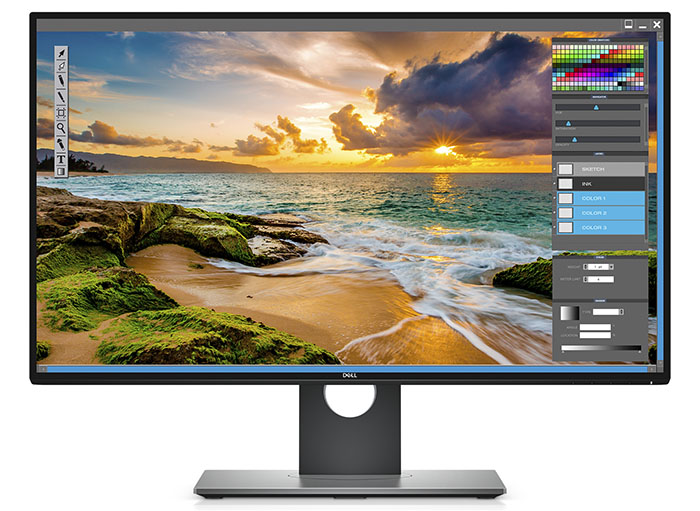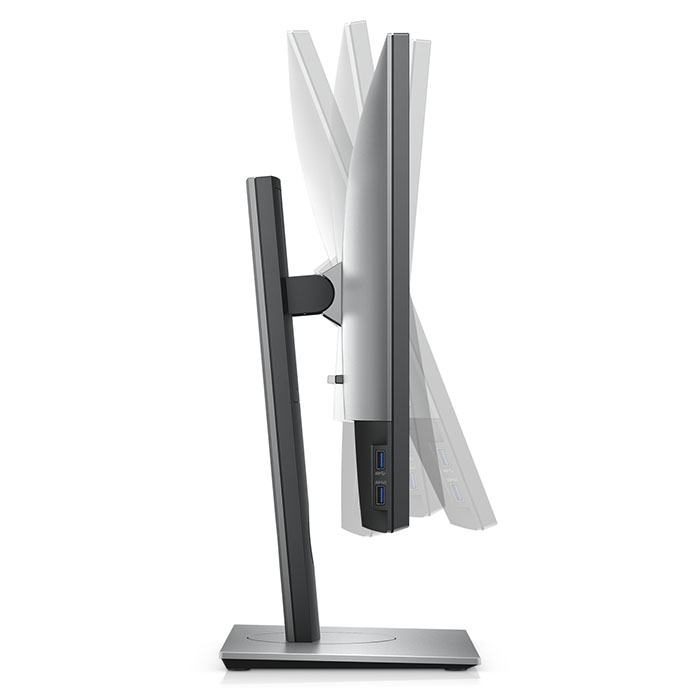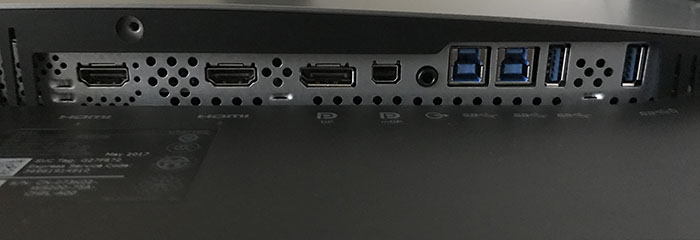Early Verdict
The Dell UP2718Q is, for now, a unique monitor. It’s the first zone-dimming backlight we’ve seen in a desktop display, and the first consumer-level panel that can truly do justice to HDR content. Coupled with reasonably accurate color that extends all the way up to Adobe RGB, you’re looking at a high-end mastering screen at a relatively affordable price. $1500 may seem like a lot, but in the professional realm it’s a bargain. Users looking to outfit their Ultra HD video post-production systems may want to give it a serious look.
Pros
- +
HDR10
- +
Ultra HD resolution
- +
DCI-P3 & Adobe RGB color
- +
Tremendous contrast in HDR mode
- +
384-zone backlight
- +
Build quality
Cons
- -
Factory calibrated modes could be more accurate
- -
Occasional halo effects in HDR mode
- -
Not enough calibration memories
Why you can trust Tom's Hardware
Introduction
Like all new video standards, High Dynamic Range (HDR) has caused its share of confusion for buyers. First, there are the three specs: HDR10, Dolby Vision, and the upcoming Hybrid Log Gamma (HLG). Not all displays support all three. Then there is the subject of just which monitors can actually do justice to the technology. Including HDR in a panel doesn’t guarantee a better picture. Many products can’t produce the extended colors required by DCI-P3-encoded content. And few HDR monitors or televisions have sufficient dynamic range to produce a significant improvement in picture quality over SDR displays.
This axiom was proved during our review of Dell’s S2718D. While the screen supports HDR10 signals, it has neither high output nor the low black levels needed to truly display HDR. It also makes do with an sRGB color gamut and QHD resolution. Clearly, Dell is aware of this, because today we’re testing the UltraSharp UP2718Q. It’s a 27” IPS panel with Ultra HD resolution, extended color that covers both DCI-P3 and Adobe RGB, and most importantly, a 384-zone backlight. Let’s take a look.
Specifications
To correctly reproduce any HDR standard, a panel needs a wide native dynamic range. That means it must produce extremely bright whites and deep blacks. The industry goal for peak output is 1000nits, or 1000cd/m2. Very few panels can reach that level however. And there are currently none that can do it over the full screen area. Using current technology, there are only two display types that can do any justice to HDR: OLED or zone-array LCDs.
The UP2718Q is the latter. Rather than using a backlight with LEDs arrayed at the edges, it employs 384 discrete light sources placed directly behind the TFT layer. Each one is individually addressable which means power can be diverted to a subset of them producing the necessary 1000nit peak. Since the panel is a traditional IPS part, black levels are on par with other monitors. But it’s that high output and zone-dimming feature that allows it to properly reproduce HDR10 content.
The UP2718Q also features an extended color gamut. It can fully render both DCI-P3 and Adobe RGB, and accepts Rec.2020 encoded signals too, displaying about 70% of that enormous colorspace. Make no mistake, this is a professional-grade tool meant for post-production use, and it carries a price tag to match. Few consumers will be plunking down the approximately $1500 cost of entry. For those in need of its unique features, however, we suspect that cost is a secondary consideration.
Packaging, Physical Layout & Accessories
Dell continues its tradition of no-foam packaging with the UP2718Q. Its carton is a clamshell-style made from double-corrugate. The interior is made from molded paper pulp that thoroughly protects the contents from shipping damage. Not only is it environmentally sound, it saves weight, which helps reduce transport costs. The panel, upright, and base are separately wrapped and must be assembled. No tools are required. Simply snap the upright on the panel’s back and attach the base with its captive bolt.
High-quality cables are included for HDMI, DisplayPort, USB, and IEC power. The enclosed CD has drivers, documentation, and software for the auto-calibration feature.
Get Tom's Hardware's best news and in-depth reviews, straight to your inbox.
Product 360



The UP2718Q takes Dell’s no-nonsense approach to styling. Every surface and corner is either smooth or rounded. There are no attempts at texture or form other than what’s needed for function. Despite its plainness, you’ll recognize it instantly as a Dell product. The bezel is relatively narrow but not flush. It varies in width from 13mm at the top, to 14mm on the sides, and 15mm on the bottom. The anti-glare layer is of high quality and complements the Ultra HD image with its super-fine 200ppi density. There is no grain or softness in evidence. Control buttons are on the bottom right and click firmly with precision. While we’d prefer a joystick, this arrangement works well and is intuitive.
The side profile is reasonably slim with a smooth taper across the back. On the left edge are two of the four USB 3.0 downstream ports. The stand is solid with firm, well-damped movements. Tilt is 21° back and 5° forward, with 90° swivel to either side, and 5.4” of height adjustment. You also get a portrait mode where the panel sits right on the desk surface which is very handy. Audio is supported only by a headphone output; there are no internal speakers.
The input panel has two DisplayPorts, version 1.4, along with two HDMI 2.0a inputs that include HDCP 2.2 copy-protection. The UP2718Q is KVM-capable with two upstream USB 3.0 ports along with four downstream connections. Signals can be routed in the OSD so you can connect one monitor to two computers.
MORE: Best Gaming Monitors
MORE: Best Professional Monitors
MORE: How We Test Monitors
MORE: How To Choose A Monitor
MORE: All Monitor Content

Christian Eberle is a Contributing Editor for Tom's Hardware US. He's a veteran reviewer of A/V equipment, specializing in monitors. Christian began his obsession with tech when he built his first PC in 1991, a 286 running DOS 3.0 at a blazing 12MHz. In 2006, he undertook training from the Imaging Science Foundation in video calibration and testing and thus started a passion for precise imaging that persists to this day. He is also a professional musician with a degree from the New England Conservatory as a classical bassoonist which he used to good effect as a performer with the West Point Army Band from 1987 to 2013. He enjoys watching movies and listening to high-end audio in his custom-built home theater and can be seen riding trails near his home on a race-ready ICE VTX recumbent trike. Christian enjoys the endless summer in Florida where he lives with his wife and Chihuahua and plays with orchestras around the state.
-
idontrememberit About the anti-glare, can you confirm if the graininess is visible on black text with white background?Reply -
gmayol Do you think this features imply the same increment in the total bill of materials than in price or engineering expenses ? should we see this technology on cheaper models ?Reply -
samer.forums $1500 is too much for this. its 27 inch only .. there are 43-55 inch TVs at the same price with the same specs , 10bit , HDR10 and wide color gamut.Reply -
hannibal The point is They have not the same nits as this device!Reply
If you read there Are Many monitors that claim hdr but can not actually show it. Same with cheap tv sets. -
samer.forums Reply20321789 said:The point is They have not the same nits as this device!
If you read there Are Many monitors that claim hdr but can not actually show it. Same with cheap tv sets.
Latest Sony TVs are VERY BRIGHT .. check them out the 2017 models. -
TheDane HDR is not about nits only. OLED TVs are superior to even the best LCD HDR TVs even though they currently max out at aroung 700 nits. I'd rather have a 500 nits "only" OLED TV than a 500 zone +1000 nits LCD TV. The per-pixel black level are important for maximum detail.Reply -
trevor_dennis Nice, but I'll never trust a Dell monitor again. My admittedly aging 2709W has had the very common vertical line issue for a few years now, and Google tells me I am far from alone. Checking the user reviews on Amazon shows an appallingly low satisfaction with new Dell screens indicating a roughly one in five chance of getting a lemon, and huge problems getting it fixed if you do. You end up with a refurbished screen (second hand) which may or may not develop the same issue. If you get a good one, they are great value, but I am just not prepared to risk it.Reply -
jn77 I have 3 Dell UltraSharp 2408WFP's and they were premium monitors at the time and 1 month after the warranty expired I got the vertical line issue on all of them. I am also done with Dell Monitor's also.Reply -
samer.forums Reply20323968 said:You lost me at 16:9 :(
True .. 16:10 is better for professional work
